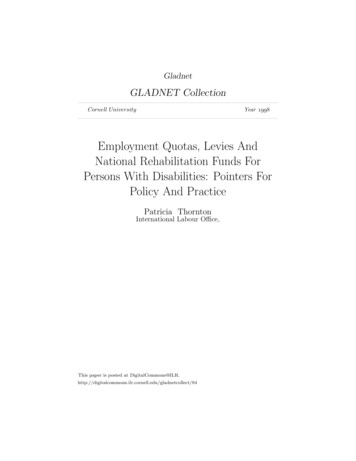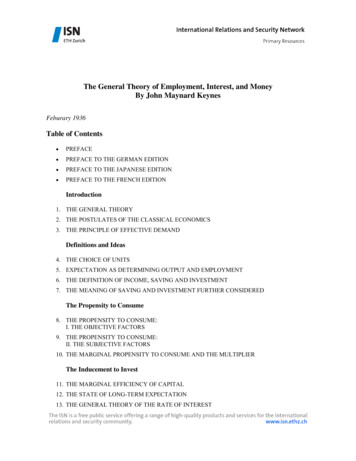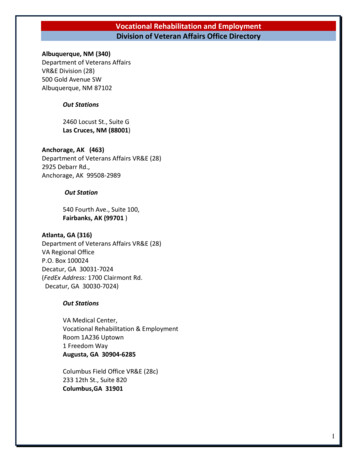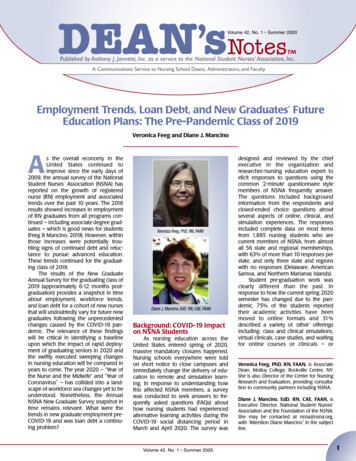
Transcription
GladnetGLADNET CollectionCornell UniversityYear Employment Quotas, Levies AndNational Rehabilitation Funds ForPersons With Disabilities: Pointers ForPolicy And PracticePatricia ThorntonInternational Labour Office,This paper is posted at ll.edu/gladnetcollect/84
Employment Quotas, Levies and NationalRehabilitation Funds for Persons withDisabilities:Pointers for policy and practiceINTERNATIONAL LABOUR OFFICE GENEVAReport prepared on behalf of the International Labour OfficebyPatricia ThorntonSocial Policy Research UnitUniversity of YorkCONTENTSFOREWORDINTRODUCTIONPART I: COUNTRY REPORTSThe system in FranceThe system in GermanyThe system in PolandThe system in JapanSUMMARY REPORTSAustriaChinaHungary
PART II: ESTABLISHING POLICYPART III: MANAGEMENT OF NATIONAL FUNDSCONCLUSIONSFOREWORDThe ILO believes that workers with disabilities should enjoy the same rights tofreely chosen, quality employment as non-disabled workers. This is reflected inILO Convention No. 159 concerning the Vocational Rehabilitation andEmployment of Disabled Persons which calls upon member States to formulate,implement and periodically review a national policy favouring the training andemployment of disabled persons. Often special measures are required to prepareindividuals with disabilities for the world of work, and to adapt the workplace fordisabled workers. Additional measures are sometimes required to ensure thatdisabled persons have access to job opportunities. Such measures include, amongothers, quota systems, levy systems and national rehabilitation funds.The ILO has noted an increasing interest in identifying effective measures forpromoting employment opportunities for disabled persons on the part of Centraland Eastern European countries, as well as by developing countries in Africa,Asia and Latin America. This interest is reflected in the number of requests to theILO for information about quota-levy systems and related rehabilitation fundsfrom countries examining such options or formulating national disability policyand legislation. Several countries have substantial operational experience withsuch systems and funds. Others, examining their possible creation, are seeking tolearn from countries such as France, Germany, Japan and Poland havingexperience with rehabilitation funds.For these reasons, the ILO Governing Body approved the organisation of aninter-regional, tripartite meeting on the subject, which was held in Warsaw from27 February to 1 March 1997. It was organised by the ILO in collaboration withthe State Fund for the Rehabilitation of Disabled Persons in Poland, with supportfrom the French rehabilitation Fund, AGEFIPH, and the German Ministry ofLabour and Social Affairs. Representatives from those bodies worked togetherover the course of a year to prepare for what became the First InternationalConference on Policies and Management of National Rehabilitation Funds.Eleven countries accepted the invitation from the ILO to be represented at theConference and representatives from a further seven countries attended asobservers. Altogether over 75 representatives of national funds, governments,employers', workers' and disabled persons' organisations, and rehabilitation andservice-providing organisations, attended the two and a half day Conference.The objective of the Conference was to foster an exchange of information on theadvantages and disadvantages of quota-levy systems and their associatednational rehabilitation funds, as one method of furthering the obligation, sharedby governments, employers and workers, to promote the effective labour market
participation of disabled persons. The programme for the Conference allowed forpresentations from representatives of countries with established quota-levysystems and associated rehabilitation funds, and contributions and questionsfrom representatives of countries with very new schemes as well as from thoseconsidering such an option. Contributions from countries with rehabilitationfunds which are not linked to quota-levy schemes added value to discussionsabout the management and distribution of funds.Plenary presentations, panel discussions and working groups reviewed theprinciples which underpin special funding mechanisms and the necessarycomplementary policies, compared the mandates of national funds and theireffectiveness in achieving desired outcomes, considered the management of thecollection and disbursement of funds, and examined the consultative and controlresponsibilities of employers', workers' and disabled people's organisations.The ILO takes no particular position on quota-levy systems but stresses theimportance of dissemination of the best possible information on which to basepolicy and practice concerning all aspects of vocational rehabilitation of disabledpeople. Accordingly, it commissioned the Social Policy Research Unit of theUniversity of York to produce this synthesis of information on existing quota-levysystems and national funds and guide to the principles and issues which shouldbe taken into consideration when designing such measures. The publicationdraws on the Conference discussions, and on the speeches and written paperspresented by the invited representatives of national funds, governments,employers' organisations, workers' organisations and disabled people'sorganisations.The publication also draws on responses from six countries to a questionnaireconstructed by the Social Policy Research Unit in conjunction with the meetingpreparation group. The synopsis of the questionnaire responses, which served asa reference document at the meeting, is appended to this report. The hard workof the meeting preparation group and of those who completed the questionnaireis gratefully acknowledged.The ILO wishes to express appreciation to the State Fund for the Rehabilitationof Disabled Persons in Poland for hosting the conference, for its very professionalorganisation, for the excellent arrangements for interpretation and translation,for the secretarial and technical support and for the excellent Polish hospitality.Thanks are due also to the staff and disabled young people of the KonstancinRehabilitation Centre where the Conference was held.INTRODUCTIONIntroducing the 'quota' conceptIn the Western world the concept of an employment 'quota' of disabled workershas a long history. Quota systems represent a deeply embedded policy approach,
developed originally in a European context, and based on long-standingacceptance of a social obligation to employ individuals with disabilities.The obligation to employ a quota of disabled workers may be adopted voluntarilybut usually it is a legal requirement. At its simplest, quota legislation requiresprivate and/or public sector employers, who employ a certain minimum numberof workers, to ensure that a given proportion of employees consists of designatedpersons with disabilities. The definition of a disabled worker who counts towardsthe quota can be broad or narrow. Usually all employers subject to the law worktowards a national target set at, say, four or six per cent of the eligible workforce,but sometimes different quotas are set according to size of a firm or industrialsector. In many but not all quota schemes, employers who do not meet theirtarget can be fined for breaking the law.Most quota schemes are more complex than this in their operation and there area number of contentious variations. For example, the employment of people withgiven characteristics, such as young people or those with severe impairments,may be double- or even triple-counted. Or types of occupation, such asconstruction, mining or working on board ship, may be considered unsuitable fora disabled person and discounted when the total workforce is calculated. In someschemes, action other than direct recruitment, such as contracting with shelteredworkshops or reaching enterprise-based agreements to further the integration ofdisabled workers, can also count towards the quota.Levy systems differ from plain quota schemes in allowing employers to make afinancial contribution, or levy, to a special fund in lieu of employing the targetproportion of disabled people. Such a contribution may be permitted only as alast resort when the possibility of direct employment has been exhausted, or maybe a legitimate choice. The levy is not conceived as a legal penalty; employers whodo not pay the levy may be fined but this option is seldom used. The levies fromemployers commonly are collected into a special rehabilitation fund andredistributed variously to employers, disabled workers or service providers. Therehabilitation fund usually complements publicly funded provision to promotetraining and employment of persons with disabilities.Given such variety in practical application, it is plain that a 'quota-levy system' isa broad concept which can be tailored to national contexts and requirements,rather than a uniform scheme.There is nevertheless a clear theme unifying the quota-levy policy approach. Thepolicy embodies the concept of a national social obligation to equaliseemployment opportunities for disabled people. The quota makes concrete thestandard which employers are expected to meet. Fulfilment of the obligation canbe encouraged and supported by the state but responsibility ultimately rests withemployers because it is they who provide jobs. The main purpose of the levy is toencourage employers to meet their quota target, not to raise revenue.
History of quota and quota-levy systemsHistorically, the quota policy approach has been a characteristically Europeanmeasure(1), although also favoured in Japan since 1960.Its origins date back to World War I, with regulations and laws in Germany and Austria topromote the integration of war-injured soldiers. Proposals to reserve jobs for disabled veteransthrough quota systems were first discussed internationally at the Inter-Allied Conference in 1920which recommended that national governments adopt legislation which would oblige public andprivate employers to employ disabled ex-soldiers. A committee of experts which met in 1923under the auspices of the ILO supported the use of legal obligations to promote employment ofdisabled ex-soldiers and proposed that employers who had a designated number of employeesshould be covered by legislation, with exemptions for those who experienced certain difficulties.Exempted employers or those who did not meet their percentage target should be obliged to pay afee or a fine.The principle of a legal obligation on employers over a certain size, with fines or levies for thosewho did not meet it, was adopted by several countries in the early 1920s, including Poland(2), andformed the basis of long-standing legislation in Austria, France, Germany and Italy.Over the years, quota systems were gradually extended to cover civilians disabled through war,victims of accidents at work and ultimately non-insured disabled people. Towards the end ofWorld War II the quota principle was reinforced by a recommendation of an ILO conference, heldin Philadelphia in 1944, that to ensure equality of opportunity for disabled workers, employersshould be induced, and where necessary compelled, to employ a reasonable quota of disabledworkers. The majority of countries with a compulsory employment scheme extended its scope inthe post-war years; and some, including the UK and the Netherlands, introduced quota legislationfor the first time (although these two countries have since abandoned mandatory schemes). Theseearly schemes were designed to function in situations of full employment.Subsequently, Greece, Luxembourg and Spain followed suit (and Ireland and Belgium introducedpublic sector schemes). The principle was further reinforced in European Union Member Statesby the European Commission Recommendation of 1986. While two-thirds of European UnionMember States now have some form of quota scheme it must be acknowledged that certainschemes are designed and implemented in a limited and ineffective manner.(3)Looking beyond the European Union, in the countries of Central and Eastern Europe quotas werewidespread after World War II but within a command economy system which allocated workersto jobs. In the 1990s, several of those countries, including Belorussia, Lithuania and the Ukraine,have legislated quotas which apply to the private sector.Japan's quota scheme dates back to 1960 (the levy-grant scheme was introduced in 1976). Egypt,Turkey and Malaysia have quota schemes extending to the private sector.(4) Quota provisions areincluded in the legislation of non-industrialised countries as varied as Angola, Mauritius, thePhilippines and Tanzania.(5)Growth of quota-levy systemsOnly a small minority of European Union countries have quota-levy systems. InAustria and in Germany, the notion of levies on employers who do not meet theirobligation to employ disabled persons dates back to 1920 and the post World War
II period respectively, while in France paying a levy as an alternative to directemployment was introduced only with the reforms of 1987.Since 1989, several 'countries in transition' have legislated for quota-levyschemes in the context of the new market economy; for example the CzechRepublic, Hungary, Poland, Romania, the Russian Federation and the SlovakRepublic. China now has a quota-levy system. African and Asian countries withquota-levy schemes, often uninforced, include Morocco, Tunisia, Azerbaidjan,Pakistan, Thailand and Vietnam.(6)Consequently, there is a new wave of quota-levy schemes set up in unique circumstances.Principles of quota and quota-levy systemsAs quota systems developed incrementally in Europe their underlying principlesbecame open to different interpretations. The original principle of a moralobligation or duty was diluted over time as beneficiaries of quota schemes wereextended to cover groups other than disabled ex-soldiers and victims ofoccupational accidents.It is now generally agreed that the quota is a form of affirmative action, in that itaims to equalise employment for a group of people who are under-represented inthe world of work. The quota may counter negative discrimination, throughencouraging an employer to extend an opportunity to a qualified individual whootherwise would be disregarded on grounds of disability alone. However, there isa competing assumption, often held by critics in countries such as the USA withno history of a quota system, that the employment obligation signals that mostdisabled people are unable to compete for and win jobs on merit; consequently,the quota is viewed by those critics as an obligation to give preference to disabledpeople on grounds of pity alone. Sometimes the quota is seen as no more than apunitive law. The quota-levy approach, on the other hand, can be viewed asencouragement, rather than punishment.The principles underpinning levy schemes are broadly similar: essentially allemployers, above a certain size, should contribute to the employment of disabledworkers, ideally through the direct provision of employment, but if this is notpossible, through a financial contribution. The aim is to maximise employmentrather than to collect revenue. In Germany, it is not possible to buy off theobligation to employ disabled people by paying the levy. In Japan, similarly,employers who contribute to the levy are still subject to the obligation to employphysically disabled people. In France, the expectation is that the voluntarycontribution should be paid only when the other possibilities of complying withthe legal obligation (employing disabled workers, sub-contracting with thesheltered work sector or implementing an agreed integration programme) cannotbe met.
The precise function of the levy varies although the principle remains similar. InGermany it is neither a device for financing rehabilitation nor an instrument ofcoercion. Rather, it is an equalisation mechanism: the levy paid by employerswho do not employ adequate numbers of disabled people is redistributed to thosewho do, to cover the extra costs they incur. In Japan, the underlying principle ofpromoting collective responsibility redistributes the levy to cover the costs ofemployers who employ physically disabled workers. In France, the policyrecognises the economic constraints facing some enterprises and allowsemployers who are not in a position to recruit, train or generally foster theemployment of disabled people to discharge their obligations by contributing to afund to aid integration of disabled individuals in enterprises which are able tosupport those aims.Quota systems in contextWith the passage of time, the quota approach has become only one among apackage of policy measures working simultaneously to promote employment ofdisabled people in the mainstream: rehabilitation, employment preparation andplacement services; job-coaching and other support on the job; financialincentives to employers and to employees; grants for assistive devices and foradaptation of work and workplace; promotion of attitudinal change andvoluntary activity on the part of employers; and legislation to outlawdiscrimination on grounds of ill-health or disability. Within this gamut ofpolicies, quota systems have lost their exclusive central position and areincreasingly seen as potentially viable only when supported by complementarymeasures. Indeed, the restrictive scope of the employment obligation, limitedadministrative capability and inadequate sanctions can severely limit the impactof the quota policy approach and reduce its credibility.Other policy instruments thus need to be in place to give meaning to quotas.These instruments are often more important than the quota legislation itself.Employers often oppose quotas, but unions often see them as the only means toexert pressure on employers to honour their social obligation towards disabledworkers. But it does not make sense to regulate for compulsory employment ofdisabled people unless a number of conditions are met, notably availability ofsuitable and accessible jobs, and disabled workers who are trained and capable ofperforming the tasks expected of them. Governments have an obligation to seethat these conditions are met if labour market integration is to be realised. It isnot legitimate to use regulations such as quotas to impose on employers theresponsibility to employ disabled workers whose qualifications, work potential orperformance are considerably reduced.In the countries of Central and Eastern Europe the quota - or, more accurately,the quota-levy approach - now appears to be the standard policy response to theemployment problems which disabled people face. Notably in economies intransition, the quota-levy is often found to be the central plank of newly createdpolicies to promote mainstream employment of disabled persons in the new
market economies. As already noted, from 1991 onwards many of those countrieshave provided for quota-levy systems in their legislation, although not all havebeen implemented. China has also introduced a quota-levy scheme.In setting up quota-levy schemes, these countries are looking to establishedsystems for models, tailoring the detail of implementation to their own nationalcircumstances. In transferring the concept from one cultural and economicsetting to another, the basic principle of the obligation to employ disabledpersons may become diluted. This is particularly likely if systems are not yet inplace to create an appropriately skilled disabled workforce or accessible workingenvironments. When the quota-levy system was legislated for in FederalGermany in 1974, meeting the six per cent quota was a real aspiration; in 1982the average quota attained was 5.9 per cent. In most new quota-levy schemes, bycontrast, the quota is far from being achieved and the purpose of the system ismore likely to be construed as revenue generation.It should be noted that, while the quota approac
individuals with disabilities for the world of work, and to adapt the workplace for disabled workers. Additional measures are sometimes required to ensure that disabled persons have access to job opportunities. Such measures include, among others, quota











